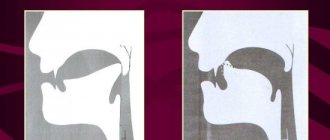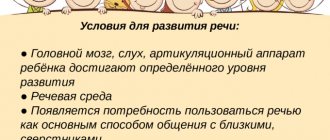Workshop meeting for parents “Our merry tongue”
Meeting-workshop for parents “Our funny tongue”
(training to perform articulatory gymnastics)
Presentation Presentation
Speech therapist teacher: Proskurneva E.V.
Greetings. Topic designation.
Hello, dear parents! I am very glad to see you at our meeting. Today we will talk to you about what articulatory gymnastics is, what it is needed for, and of course, we will learn how to perform various exercises ourselves, so that you can then learn them with your children. I will also tell you about non-traditional articulation games, games for the development of speech breathing. We will also learn how to massage the tongue using an ordinary toothbrush.
Theoretical part
Every person pronounces sounds correctly due to good mobility of the organs of articulation. These include:
soft sky,
lower jaw,
tongue and lips,
All speech organs consist of muscles, and therefore they can be trained, just like the muscles of the arms, legs, back, etc.
This is why there is articulatory gymnastics, which allows you to strengthen the muscles of the articulation organs and prepare the basis for pure sound pronunciation.
Undoubtedly, initially a complex of articulatory gymnastics is practiced by a speech therapist, and only after that is it offered for practice at home with parents, since it is necessary to practice daily so that the skills developed in children are consolidated. To do this, dear parents, you need to learn how to perform articulation gymnastics correctly!
.Articulation gymnastics must be carried out daily (for 3-5 minutes) so that the motor skills developed in children are consolidated and become stronger.
Articulation gymnasts are performed while sitting, the back should be straight, the body should not be tense, the arms and legs should be in a calm position.
During articulation gymnastics, a child and an adult should be in front of a large wall mirror, since the child must clearly see the adult’s face, as well as his own face, in order to independently control the correctness of the exercises (you can use a small hand mirror, but then the adult should be facing the child to him).
Classes should be held in a playful way, because this is the main activity of children. You can choose a picture or image for each exercise.
- some exercises are performed while counting, led by an adult. This is necessary so that the child develops stability in the most important positions of the lips and tongue; —
You should not give more than two or three exercises, and you should move on to subsequent exercises only after the previous ones have been mastered;
- if you have difficulty performing the exercises, you need to return to simpler, already worked out material;
Practical part
To begin with, I suggest you learn how to do tongue exercises. For this you will need mirrors. We position them so that you can clearly see the lower part of the face.
First, let's do exercises for speech breathing. Well-executed speech breathing ensures clear diction and clear pronunciation of sounds. It is advisable to perform 1-3 exercises before each complex of articulatory gymnastics. All these exercises will help you achieve smooth exhalation and quickly master difficult-to-pronounce sounds.
Air must be taken in through the nose, without raising your shoulders.
The exhalation should be long and smooth. It is important that the child blows forcefully (and not just exhales)
It is necessary to ensure that your cheeks do not puff out (at the initial stage, you can press them with your palms).
The air stream should be narrow and cold. If the air stream is warm, diffuse and a sound similar to X is heard, then the child is blowing incorrectly.
After each exercise, give your child a rest.
It's important not to overdo it! 3-5 repetitions are enough. Doing these exercises repeatedly can lead to dizziness.
Exercises for developing speech breathing:
Exercise “Whose breeze is stronger?”
Goal: to develop a targeted air stream.
Description: stretch out your lips with a tube, draw in air and blow forcefully into your palm; do it 3-4 times.
Methodical instructions: the air stream is continuous, the cheeks do not inflate.
Exercise “Push the ball into the goal”
Goal: to develop a targeted air stream.
Description: stretch out your lips with a straw and blow on a cotton ball for a long time (the cotton ball lies on the table); the child blows on the “ball”, trying to “score a goal”; the ball should end up between the cubes.
Methodical instructions: the air stream is continuous, the cheeks do not inflate.
Exercise “Blow a snowflake”
Goal: to develop a targeted air stream running in the middle of the tongue.
Description: smile, place the wide tip of your tongue on your lower lip; take a breath and, as if pronouncing a long sound [F], blow away the “snowflake” (cotton ball) from the palm of your hand. Repeat 3-4 times, gradually moving the palm with the “snowflake” to an ever greater distance
Methodical instructions: the lower lip is not pulled over the lower teeth; cheeks do not puff out;
Articulation exercises:
You can use special books and manuals, of which there are a lot now, for example, the book by N.V. Nischeva "Fun articulatory gymnastics."
Exercise “Fence”, “Smile”, “Puppy”
Goal: To develop the ability to keep teeth clenched; improve the circular muscles of the lips.
Description: smile, show upper and lower teeth.
Methodical instructions: teeth are closed; the muscles of the cheeks and lips are very tense; it is necessary to ensure that the child does not wrinkle his nose; hold the position for a count of 5.
Puppy smiles
Teeth on display
I could do the same
Look, now.
Exercise “Window”, “Hippopotamus”
Goal: To develop the circular muscles of the lips.
Description: starting position “Fence”, then slowly open your mouth.
Guidelines: upper and lower teeth are clearly visible; the muscles of the cheeks and lips are very tense; hold the position for a count of 5.
The hippopotamus opened its mouth
He held it, then closed it.
We'll tease the hippopotamus
I want to make fun of him.
The “Fence” and “Window” positions are the starting point for all other exercises.
Exercise “Tube”, “Proboscis”
Goal: To develop lip mobility.
Description: from the “Fence” position, stretch your lips with tension with a tube (“Proboscis” - the same, but slightly open your lips).
Methodical instructions: lips are tightly closed so that there is no hole in the center; teeth are closed; the circular muscle gathers into wrinkles.
The baby elephant pulls his proboscis,
He's about to get a banana,
Fold the sponges into a tube
And show the baby elephant.
Alternating exercises “Fence” - “Tube”
Exercise "Spatula"
Goal: To develop the ability to relax the muscles of the tongue and hold it in this position for a long time.
Description: from the “Fence” position to the “Window” position, place the wide tip of the tongue on the lower lip.
Methodical instructions: the tongue should be calm (if you can’t relax your tongue, you can spank it with your lips: “five-five-five”) and wide (its edges touch the mouth); the lower lip should not curl up; the upper lip should expose the teeth; hold for a count of 5.
Here in the shoulder blade
turned and fell apart on a sponge. He spread out, stretched out and smiled with his lips.
You can use other manuals and pictures. The essence of all articulation exercises is the same.
Exercise "Clock"
Goal: To develop the lateral muscles of the tongue and coordination of movements (from right to left).
Description: from the “Fence” position, move to the “Window” position, and then to the “Needle” position; move the tip of the tongue in a “one-two” count (tick-tock), from one corner of the mouth to the other (an adult counts).
Methodical instructions: the lower jaw remains motionless; hand under the chin to control the immobility of the lower jaw.
The tongue, like the pendulum of a clock, is ready to swing again and again. The kitten smiles, He, like you, tries.
Exercise "Swing"
Purpose: To practice quickly changing movements of the tip of the tongue; practice coordination of movements of the tip of the tongue (up and down).
Description: from the “Fence” position, go to the “Window” position, and then to the “Spatula” position; alternately rest the wide tip of the tongue on the upper and lower teeth.
Methodical instructions: alternate movements 5 - 6 times at a pace set by an adult; the lower jaw remains motionless (hand under the chin to control the motion of the lower jaw).
Higher than the oak, higher than the spruce, we took off on a swing. Tell me, would you be able to “pump a swing” with your tongue?
Exercise “Punish the naughty tongue”
Goal: To develop mobility of the tip of the tongue.
Description: from the “Fence” position, move to the “Window” position, and then calmly place your tongue on your lower lip and:
- spanking it with your teeth, pronounce the sounds “ta-ta-ta”;
— spanking it with your lips, pronouncing the sounds “five-five-five.”
Methodical instructions: the lower lip should not be tucked in or pulled over the lower teeth. The tongue should be wide, its edges touching the corners of the mouth. You need to pat your tongue with your teeth (lips) several times in one exhalation. Make sure that the child does not hold back the exhaled air. You can check the implementation like this: bring the cotton wool to the child’s mouth; if he does the exercise correctly, it will deviate.
Exercise “Horse”
Goal: Learn to stretch the hypoglossal ligament of the tongue.
Description: from the “Fence” position, go to the “Window” position, and then click your tongue.
Methodical instructions: perform 5-6 times; the lower jaw remains motionless; hand under the chin to control the immobility of the lower jaw.
And now, look, these are horses galloping.
Click your tongue like they click their hooves.
Exercise "Cup"
Goal: Activate the muscles of the tongue.
Description: from the “Fence” position, go to the “Window” position, and then to the “Spatula” position; bend the wide edges of the tongue slightly upward; hold for a count of 5.
Methodical instructions: the lower lip should not be pulled over the lower teeth; the lips remain in the “Fence” position.
Let's bend the edges of the tongue, do the same as I do. The tongue lies wide and, like a cup, deep
Exercise "Painter"
Goal: To develop tongue mobility in the upper position.
Description: from the “Fence” position, move to the “Window” position, and then to the “Spatula” position; move the wide tip of the tongue along the palate back and forth; perform 4-5 times.
Methodical instructions: the tongue does not come out of the mouth; hand under the chin to control the immobility of the lower jaw.
Like a painter
Our Tongue, Painted the attic with a brush. Not the attic, but the sky! He has a lot to do!
Exercise "Mushroom"
Goal: Learn to stretch the hypoglossal ligament of the tongue.
Description: from the “Fence” position, move to the “Window” position, and then “glue” (suck) the tongue to the palate; hold for a count of 5.
Methodical instructions: if this doesn’t work, you can slowly click your tongue (“Horse”); when you feel your tongue “sucking” to the roof of your mouth, leave it there; lips remain in the “Smile” position; hand under the chin to control the immobility of the lower jaw.
There is a fungus on a thin stalk near the path. Stick your tongue to the roof of your mouth and pick a mushroom.
Exercise "Accordion"
Goal: To develop movements of the wide tip of the tongue in the upper position. Learn to stretch the hypoglossal ligament of the tongue.
Description: from the “Mushroom” position, without releasing the tongue, forcefully lower and raise the lower jaw; repeat 5-6 times.
Methodological instructions: it is necessary to ensure that the tongue does not “come unglued”; lips remain in the “Fence” position; the upper and lower teeth are clearly visible.
There are also non-traditional articulation exercises or articulation games.
"Nippers." Bite a soft piece of bread, hard cookies, etc. with your teeth or lips.
"Beads." Collect large cookie crumbs or small candies (beads) with your lips. Transfer beads from one plate to another with your lips.
"Ugh". Take a large crumb from the plate with your lips, hold it between your lips and spit into a glass.
"Kiss". Stretch your lips and kiss your palm, mirror, toy.
"Hamster". Take water into your mouth, puffing out both cheeks. Slap your fists on your cheeks and forcefully release a stream of water into the sink. Drive water from one cheek to the other.
"Sweet cheeks" Use a candy to draw lines on the inside of your cheeks, then lick off this sweetness with your tongue.
"Rinsing". Take water into your mouth, gargle, gargle, then spit out the water.
"Tooth Fairy". Clean your teeth, tongue, and cheeks with a toothbrush.
"Licking". Lick a plate smeared with jam with your wide tongue, saying “Aaam” or “Aaah.”
“Oh, how delicious!”
Lick a plate sprinkled with small crumbs of bread and sugar with your wide tongue, saying “Oh, how delicious!”
"Fishing". Touch the tip of your tongue to a large crumb so that it sticks and eat it. (The tongue is a fishing rod, the crumbs are fish).
"Jam". Lick your lips with your tongue in a circle, in 4 directions (top, bottom, right, left), licking the jam.
"Apple" Pull out a piece of apple from behind your cheek with your tongue.
"Cup". Touch the middle of the tongue with a stick and make a small indentation (cup). Drip water from a pipette into the cup.
"Snail". Make a depression in the tongue and use a sweet stick to draw a spiral (snail).
MASSAGE with a toothbrush is very useful for children with speech impairments.
MASSAGE WITH A TOOTHBRUSH
Equipment:
individual toothbrush, tongue napkin
Sit the child down, make a “spatula” (the speech therapist holds the tip of the child’s tongue with a napkin)
1. “The tongue woke up and stretched”
Use the back of the brush to move from the middle of the tongue to the tip
2. "Sun"
Move the brush in directions from the center to the periphery (do not touch the root of the tongue!)
3. "Herringbone"
First, move the brush along the length of the tongue, then along the lateral edges of the tongue
from center to periphery
4. "The wind blows to the right"
Move the brush in horizontal lines from left to right
5. “Smoke is coming from the chimney”
Zigzag movements of the brush along the surface of the tongue from root to tip
6. "The wind blows to the left"
Move the brush in horizontal lines from right to left
7. "It's Raining"
Tap the tongue with the bristles of a brush
8. "Leaves are Falling from the Trees"
Tap the back of your tongue
side of the brush
Summarizing
Thus, these simple exercises contribute to the development of the muscles of the articulatory apparatus, which prepares the child to pronounce missing sounds and help correct incorrect sounds. And as a reminder about our meeting today, I offer you the booklets “Recommendations for conducting articulatory gymnastics and massage with a toothbrush.”
5







